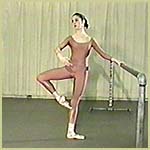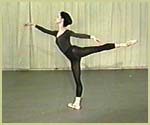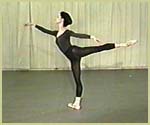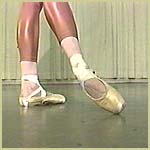Ballet Terminology And Definitions Written Assessment(Int 2)

This quiz is to test your knowledge on classical ballet terminology and its definitions. You must have 75% of the questions correct to pass. You have 45 minutes to complete the assessment.
- 1.
A plié is a bending movement of the...
- A.
Ankles
- B.
Elbows
- C.
Knees
Correct Answer
C. KneesExplanation
A plié is a ballet term that refers to a bending movement of the knees. In ballet, dancers often perform pliés to warm up and strengthen their leg muscles. This movement involves bending the knees while keeping the heels on the ground and the back straight. It is an essential technique in ballet as it helps with balance, control, and proper alignment of the body. By bending the knees, dancers can achieve a deep and controlled movement that adds grace and fluidity to their performances.Rate this question:
-
- 2.
What does 'tendu' mean?
- A.
Stretched
- B.
Slide
- C.
Glide
Correct Answer
A. StretchedExplanation
The word 'tendu' is a ballet term that comes from the French language. In ballet, 'tendu' refers to a movement where the leg is stretched and extended along the floor, while maintaining contact with the floor. Therefore, the correct answer is "Stretched" as it accurately represents the meaning of 'tendu' in ballet.Rate this question:
-
- 3.
Ront de jambe is a ________ movement of the leg
Correct Answer
circular , round, circleExplanation
Ront de jambe is a movement of the leg that follows a circular or round path. It involves the leg being lifted and extended in a circular motion, either in front or to the side of the body. This movement is often used in ballet and other dance forms to create fluidity and grace in the choreography.Rate this question:
- 4.
A raising of the body on pointes or demi-pointes is called a...
- A.
Pirouette
- B.
Jeté
- C.
Relevé
Correct Answer
C. RelevéExplanation
A relevé is a ballet term that refers to the action of raising the body onto the tips of the toes or onto the balls of the feet. It is commonly used in ballet to create an illusion of floating or lightness. In a relevé, the dancer lifts their body up, using the strength of their legs and feet, while maintaining a straight alignment. This movement is often used as a preparation for other ballet steps or as a way to transition between movements.Rate this question:
-
- 5.
What is this position called?
- A.
Relevé
- B.
Retiré
- C.
Rond de jambe
Correct Answer
B. RetiréExplanation
Retiré is a ballet position where the working foot is placed on the inside of the supporting knee. This position is commonly used in various ballet movements, such as pirouettes and jumps. It requires strength and balance to maintain the position while executing other steps.Rate this question:
-
- 6.
En Dehors means ______.
Correct Answer
outward , outside , outwardsExplanation
En Dehors is a French term that translates to "outward" in English. It is used to describe movements or positions that are directed away from the body's center or towards the audience. In dance, En Dehors refers to movements that rotate or turn outward, away from the body's midline. This term is commonly used in ballet and other dance styles to indicate a specific direction or quality of movement.Rate this question:
- 7.
En Dedans means ______.
Correct Answer
Inward, withinExplanation
En Dedans is a term used in ballet to describe a movement that is performed inward towards the supporting leg. It refers to the action of turning the working leg inward, towards the midline of the body. This movement is often used in various ballet steps, such as pirouettes and développés. Therefore, the correct answer for this question is "Inward".Rate this question:
- 8.
What is the correct spelling for this classical ballet move shown in this photo?
- A.
Arabesk
- B.
Arabesque
- C.
Arrabesque
Correct Answer
B. ArabesqueExplanation
The correct spelling for this classical ballet move shown in the photo is Arabesque. An Arabesque is a ballet position where the dancer stands on one leg with the other leg extended behind them, and the arms are held in various positions. It is a graceful and elegant movement that requires balance and control.Rate this question:
-
- 9.
Which ballet position is this?
- A.
1st arabesque
- B.
2nd arabesque
Correct Answer
A. 1st arabesqueExplanation
The given ballet position is 1st arabesque. In this position, the dancer stands on one leg with the other leg extended behind, and the arms are lifted, with one arm extended forward and the other arm extended to the side. This position requires balance, strength, and flexibility. It is a fundamental position in ballet and is often used in choreography to create beautiful lines and shapes.Rate this question:
-
- 10.
What is this called when the dancer turns their foot in from the ankle, therefore breaking the straight line of the leg?
- A.
Stickling
- B.
Sickling
- C.
Tendu
Correct Answer
B. SicklingExplanation
Sickling is the term used when a dancer turns their foot in from the ankle, causing the leg to lose its straight line. This is considered a technical error in dance and can affect the overall aesthetic and alignment of the movement.Rate this question:
-
- 11.
What is an adage?
- A.
A series of exercises following the centre practice, consisting of a succession of slow and graceful movements which may be simple or of the most complex character, performed with fluidity and ease. These exercises develop a sustaining power, sense of line, balance and poise which enables the dancer to perform with majesty and grace
- B.
Brisk and Lively movement.
- C.
A step in which the working foot slides well along the ground before being swept in the air.
Correct Answer
A. A series of exercises following the centre practice, consisting of a succession of slow and graceful movements which may be simple or of the most complex character, performed with fluidity and ease. These exercises develop a sustaining power, sense of line, balance and poise which enables the dancer to perform with majesty and grace -
- 12.
What is a jete?
- A.
Gliding on the floor
- B.
It's a jump from one foot to the other in which the working leg is brushed into the air and appears to have been thrown.
- C.
Sustained movement
- D.
Beating action of the leg
Correct Answer
B. It's a jump from one foot to the other in which the working leg is brushed into the air and appears to have been thrown.Explanation
A jete is a type of jump in dance where the dancer jumps from one foot to the other. During the jump, the working leg is brushed into the air and appears as if it has been thrown. This movement creates a sense of lightness and fluidity in the dancer's performance.Rate this question:
-
- 13.
Degage means?
- A.
To turnout the legs.
- B.
To spin on the spot
- C.
To point the fully arched foot to an open position.
Correct Answer
C. To point the fully arched foot to an open position.Explanation
Dégagé is a term used in ballet to describe a movement where the fully arched foot is pointed to an open position. This movement helps to strengthen the feet and legs while also improving flexibility and control. It is often used as a preparatory step for more complex movements in ballet.Rate this question:
-
- 14.
A pirouette is A complete turn of the body on ___ foot, on pointe or demi-pointe.
Correct Answer
oneExplanation
A pirouette is a ballet move where the dancer completes a full turn of the body on one foot, either on pointe (the tips of the toes) or demi-pointe (the balls of the feet).Rate this question:
- 15.
Choose 3 classical dance moves which were part of your allegro in your practical ballet assessment.
- A.
Sissone
- B.
Jete
- C.
Echappe
- D.
Glissade
- E.
Pirouette
Correct Answer(s)
A. Sissone
C. Echappe
D. GlissadeExplanation
The correct answer is Sissone, Echappe, and Glissade. These three classical dance moves are commonly included in allegro sequences in ballet. Sissone is a jump from two feet to one foot with the other leg extended in the air. Echappe is a movement where the dancer's feet start in a closed position and then open to a demi-plié in a slightly turned out position. Glissade is a gliding step where the dancer transfers their weight from one foot to the other while sliding the foot along the floor. These moves require strength, control, and precision, making them essential elements of a ballet allegro.Rate this question:
-
Quiz Review Timeline +
Our quizzes are rigorously reviewed, monitored and continuously updated by our expert board to maintain accuracy, relevance, and timeliness.
-
Current Version
-
Mar 18, 2024Quiz Edited by
ProProfs Editorial Team -
Mar 10, 2009Quiz Created by
Joanbeattie






